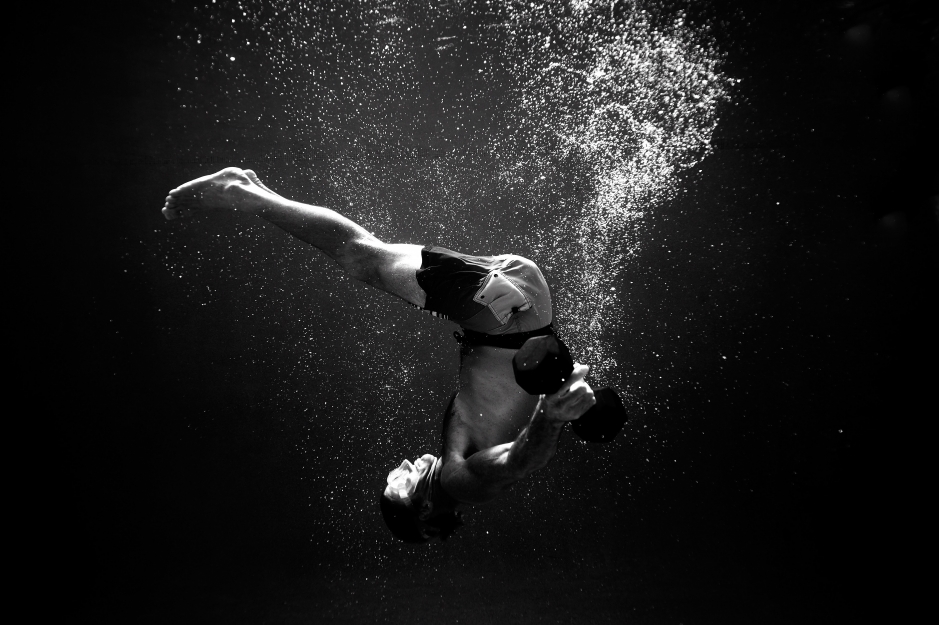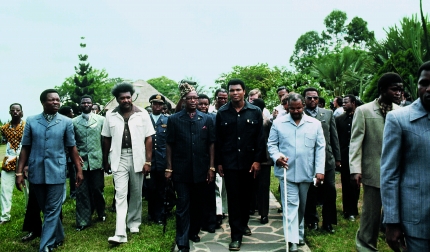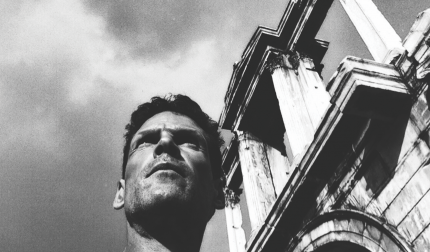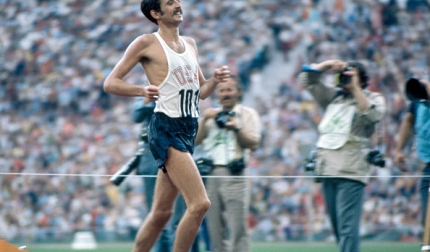From the street, Laird Hamilton’s Malibu home is disguised by a concrete wall and a dull, gray iron gate. But the curb overflows with luxury automobiles, a dead giveaway that behind this barrier Hollywood glitterati meet for secret training sessions. I squeeze my rented Nissan between a Porsche and a Bentley. I approach on foot, and as I get closer I can make out sounds of splashing water and tribal music.
As it turns out, Hamilton, the legendary surfer, owns one of the largest private outdoor pools in Southern California—which says quite a bit considering how access to water in Los Angeles is as much a status symbol as it is an occasional necessity to seeking relief from the summer heat. It’s 12 feet deep in order to facilitate the underwater exercise routines he’s been experimenting with. The boot camp that Hamilton runs—what he calls XPT, which stands for Extreme Pool Training—is the most exclusive workout in the city.
Rather than spend a lot of time asking him questions, Hamilton tells me to just get in the water and get a feel for it myself. He wants to put me through a couple of his introductory routines, so I dive in with a mask on and start treading water. Hamilton grabs two 25-pound weights, places them on the rim of the pool, and then jumps in next to me. Using only hand signals he directs me to watch his movements, and without more explanation he grabs both weights off the deck and sinks quickly to the bottom. Landing in an underwater squat he raises the two dumbbells over his head and then uses his coiled legs to blast off the ground, sending his body rocketing toward the surface in a reverse dive. To add power to the movement he strokes downward with the 50 added pounds of lead, using them like makeshift fins. His head breaks out of the surface just long enough to take a giant breath of air before sinking again to the bottom. This is one rep of potentially dozens. The underwater power jumps are supposed to roll out one after another. Once he’s muscled through 10 repetitions he gives me a smile and places the metal weights on the pool deck. “The trick is in the jump,” he says. “You won’t get very much power in the stroke when you’re holding the weights.” And with that, I grab the same set of dumbbells and let them carry me into the depths.

Legendary volleyball star Gabrielle Reece trains with husband Laird Hamilton at their pool in Malibu.
At first the movement is not completely intuitive. It’s strange to move underwater and not be swimming, but it’s also impossible to float while carrying so many extra pounds. So I focus on imitating Hamilton’s form and plant my feet firmly on the ground, crouch into a squat, and launch myself upward while letting my arms fall to my side in a rough imitation of what I’d just seen Hamilton do. I have enough force to clear the surface and just enough time to gasp for air before the weights drag me back down.
The first few reps aren’t too bad. I find a rhythm when I bob to the surface, take a gulp of air, and sink back down. But every time I hit the apogee of the movement I suck in just slightly less air than I’ve used. I’m running on a deficit. After five reps I begin to struggle. I am not sure I have the power to reach the surface with the lead in my hands, so I gather myself by walking along the floor of the pool to its concrete edge. I look up through the mask and figure I can make one last jump. I jump, push the weights above my head, and have just enough power to heave them up and set them on the deck.
Over the next couple of hours Hamilton runs me through a half-dozen other exercises. There are also just simple underwater laps in which I try to do as many lengths as possible on a single breath, or, occasionally, just one gulp of air on either side. Every exercise starts off reasonably easy but gets progressively harder as oxygen becomes a scarcer resource. It’s the sort of training that works best in the company of world-class swimmers who are paying attention to every awkward stroke. The dangers, after all, are real. Getting someone out of the pool quickly if they “go floppy,” as Hamilton calls it, is something they always have to be ready for. If someone is trying these particular exercises without supervision, it would be pretty easy to reach that limit of human endurance and simply pass out in the water. While that might be okay with landlubber’s breathwork, the consequences are more severe underwater where a gasp means drowning. But if I can get beyond that—and under Hamilton’s gaze, I am hopeful that I can—then perhaps I’ll be able to force the wedge a little deeper between my mind and body.

In any event, the weight exercises are surprisingly low impact. Most people leave Hamilton’s workouts refreshed rather than exhausted. Part of the reason could be because he demands that everyone who attends also conditions their body with alternating ice baths and sauna sessions.
Hamilton shows me a hidden alcove between the pool and his mansion where he keeps an outdoor ice bath and his ice machine. “You have to stay in for at least three minutes,” he says, gesturing to the aluminum contraption that looks like a cross between a cattle trough and an industrial milk tub. So I get in and feel the frigid water close around me. As I cool in the ice, I eye some sort of churning device at the end of the tub. When it’s on, it keeps the water in constant motion. The moving water prevents body heat from forming a small, insulating layer of warmish water when a person remains still. I lay back and close my eyes. The ice feels good. I stay put for 5 minutes, and when I turn it on, the circulator changes the calculus of my ice bathing. It takes more focus to stay warm.
Hamilton heard about the Wim Hof Method, which I have been studying and practicing myself, through a 10-week online course on the Dutch fitness guru’s Innerfire website. For Hamilton, using the cold makes sense. He grew up swimming in the tropical waters in Oahu, where hypothermia was always a present danger. Even warm Pacific waters slowly leach away heat from submerged swimmers, and for people waiting around on a surfboard for just the right set without a wetsuit, it’s easy for them to end up shivering uncontrollably. Hypothermia is far from unknown to warm water surfers. Yet Hamilton can spend half a day in the water and says controlling his body temperature is half the reason he has any success riding big waves.
As a constant tweaker of workout routines, Hamilton has also found a few ways to eke out just a little more performance from the Wim Hof Method, which combines cold exposure and breathing exercises with meditation. While ice and sauna immersion between underwater routines improve the circulatory muscles in his vascular system, Hamilton has modified Hof’s breathing method to help him excel at endurance events on land. The way he explains it, every workout has an ultimate limit where the physical load of an exercise increases the heart rate, and accordingly respiration goes up to compensate until the body simply runs out of oxygen and the movement stops. This basic concept of biomechanics dictates that as the body moves, a person needs more oxygen to fuel the motion.
Exhaustion is just the inevitable result of what happens when breathing hits its maximum rate and the body can’t get enough energy into the system. Yet Hamilton assures me that exhaustion like this isn’t only a mechanical problem, it’s also a conceptual one. “If you have to stop to catch your breath, then you probably started the race all wrong in the first place,” he tells me. “Instead, if you lead with a breathing pattern like you are already at your maximum load, then you won’t have to work so hard later.”
To demonstrate, he shows me the breathing pattern he uses to lead into his workouts. His lips bulge stiffly outward and his eyes narrow to slits as he sucks air in coarsely through his nose. Waiting just long enough for his lungs to fully draft, he exhales with a growl reminiscent of Maori warriors as they perform a haka. Taking a breath every second makes him sound like he is under heavy labor. His face flushes with exertion but his eyes have the serene gaze of a mind focusing only on the action of its lungs. After 50 breaths he inhales deeply and is ready to run. The process scrubs carbon dioxide from his lungs, allowing his body to run more efficiently.
Technically, hyperventilating and swimming underwater can pose a serious danger of blacking out and drowning, even for expert swimmers. Since the body is designed to sense CO2 levels in the blood, not the presence of oxygen, a breath-hold diver who has expelled CO2 out of his lungs has very little warning when his actual oxygen levels are seriously low. Freedivers generally stay away from the technique for their deep water plunges, and the U.S. Navy Diving Manual issues stern warnings to any military personnel who attempt it without a proper safety protocol in place.
Which is why, when I join Hamilton in a series of breath-hold laps in his pool with three of his friends for the following morning session, I am wary of what might happen if I or someone else goes “floppy.” To his credit, Hamilton recognizes that what we are doing today carries a risk of blacking out in the shallow end of his pool. So we are going to have to stay close together and be hyper-aware of how everyone else is doing in case someone needs to quickly exit the pool. Today’s session is an experiment, and one that he is not sure will get incorporated into the canon of XPT.
The five of us face off on alternate sides of the pool’s shallow end, with three on one side and two on the other. The plan is to do three rounds of breathing and breath-holds and then dive under the water with empty lungs to do as many laps as we can. “There’s something different about swimming with no air in your lungs,” says Hamilton. “You might not go as far, but you pass out in a different way. It’s slower.” Perhaps this is because the goal of swimming with empty lungs isn’t about extending the length of time underwater as much as it is about expanding the wedge between your conscious mind and your body’s actual limits. Since the body will process oxygen in the bloodstream and then expel the waste CO2 back into the lungs, the body may have a chance to sense CO2 build-up before actually blacking out.

We swim between each other like interlocking fingers and I easily reach the opposite side and flip around for a return lap. I remember a warning Hamilton gave me earlier to try not to sprint underwater but instead to take every stroke slowly and conserve my resources. I kick out to the alternate wall just a little slower than my first pool length. I can see that the others are headed for a third lap so I plunge ahead with them. Hamilton’s blue bathing suit flickers past with fishlike efficiency. Three lengths down, I turn and head into the fourth lap with darkening senses. Four strokes later I can feel something shaking deep within me. I’ve been underwater for about a minute and I want to breathe, but instead I let out some of the CO2 that has built up in my lungs. It is enough to enable me to finish the lap, but when I come to the surface the world feels a little darker than it had been a minute or two earlier.
I grasp the edge of the pool and close my eyes. I take a single deep breath and then hold it. The shake that is welling up in me grows a little stronger and soon a shudder rocks through my core. Then, as I gaze out into the starry blackness behind my lids, I see a sunburst of reds and yellows. I can feel the pool tile beneath my forearms as my head bobs down. The fireworks hang in the black void for a moment and begin to transform into a shape that resembles a human face with two black slits for eyes and a halo of flame around them. The image stays for a second before I take another breath and open my eyes.
It’s not uncommon to hallucinate during longer breath-holds. The deprivation of oxygen peels back layers of the brain, shutting them down until you reach a sort of primal center of human existence. The brain’s electrical patterns fire in sporadic ways as a person begins to lose consciousness. The process is rooted in our basic biology, but for Hamilton the experience has deeper meaning than a simple physical reaction.
“Breathing lets you go deep,” he says to me later, describing how his daily 20-minute routine of deep breathing and breath-holding has led him to places he never expected he would reach. “Sometimes I’ll see a face looking back at me and I know that it’s my own soul. At other times it feels like I’m floating above my body looking down at myself meditating.” The face he sees most, he says, resembles the crude features of the comic book hero the Silver Surfer—something that is otherworldly and yet also human. I’m not entirely surprised that the deity he identifies with owns a surfboard.
It is open to debate whether what I’ve seen on the edge of unconsciousness is a connection to something that truly transcends the world we live in or is instead the machinations of my hypoxic mind attempting to create meaning out of meaningless physical phenomenon. Clinical literature often reports different types of hallucinations that can occur during meditation. But for Hamilton and, indeed, many people who delve deeply into their own physiology through meditation or yoga, there is an intrinsic connection between the body and the soul, and every such experience has the potential to open a window into something greater. Whatever it means, just like a dream the experience itself is real.
Also real, of course, is the possibility of actually passing out underwater. If I’d gone a little farther—another lateral lap of the pool—the vision could have been a precursor to my mind shutting down and fainting. In unconsciousness my autonomic nervous system would take over and my lungs would have filled with water. Shortly after the session is over Hamilton gets in touch with me to say that they aren’t going to mix breathwork and waterwork anymore. While the underwater laps are interesting, the risks that come along with them just aren’t worth it. Moving forward, he thinks it will be better to keep that part of the training on dry land.
________________________________________________________________
Note: The underwater exercises described here are inherently dangerous and should never be undertaken without appropriate experience, training, fitness level, doctor approval, and supervision.
Adapted and excerpted from What Doesn’t Kill Us, available wherever books are sold, with the permission of Rodale.





